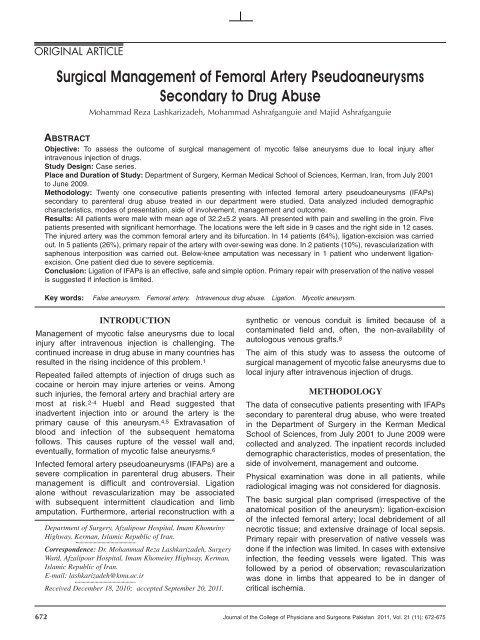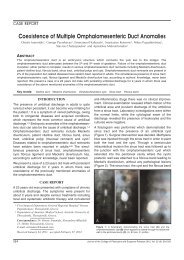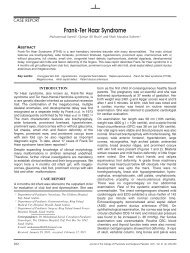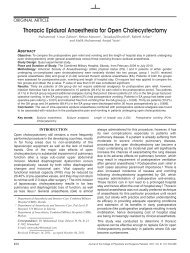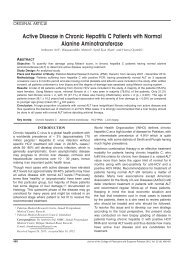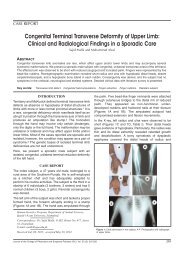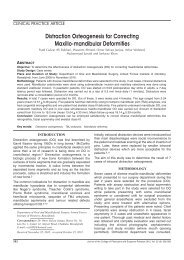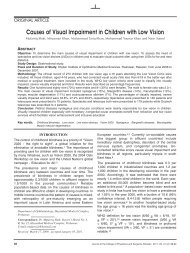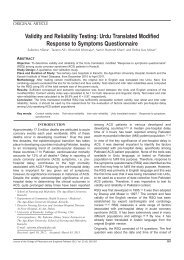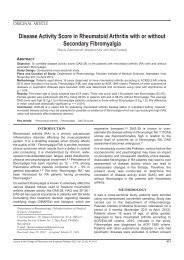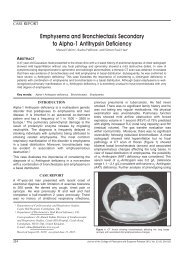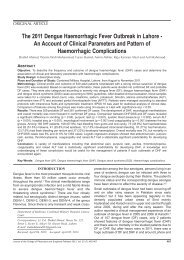Surgical Management of Femoral Artery Pseudoaneurysms ...
Surgical Management of Femoral Artery Pseudoaneurysms ...
Surgical Management of Femoral Artery Pseudoaneurysms ...
Create successful ePaper yourself
Turn your PDF publications into a flip-book with our unique Google optimized e-Paper software.
ORIGINAL ARTICLE<br />
<strong>Surgical</strong> <strong>Management</strong> <strong>of</strong> <strong>Femoral</strong> <strong>Artery</strong> <strong>Pseudoaneurysms</strong><br />
Secondary to Drug Abuse<br />
Mohammad Reza Lashkarizadeh, Mohammad Ashrafganguie and Majid Ashrafganguie<br />
ABSTRACT<br />
Objective: To assess the outcome <strong>of</strong> surgical management <strong>of</strong> mycotic false aneurysms due to local injury after<br />
intravenous injection <strong>of</strong> drugs.<br />
Study Design: Case series.<br />
Place and Duration <strong>of</strong> Study: Department <strong>of</strong> Surgery, Kerman Medical School <strong>of</strong> Sciences, Kerman, Iran, from July 2001<br />
to June 2009.<br />
Methodology: Twenty one consecutive patients presenting with infected femoral artery pseudoaneurysms (IFAPs)<br />
secondary to parenteral drug abuse treated in our department were studied. Data analyzed included demographic<br />
characteristics, modes <strong>of</strong> presentation, side <strong>of</strong> involvement, management and outcome.<br />
Results: All patients were male with mean age <strong>of</strong> 32.2±5.2 years. All presented with pain and swelling in the groin. Five<br />
patients presented with significant hemorrhage. The locations were the left side in 9 cases and the right side in 12 cases.<br />
The injured artery was the common femoral artery and its bifurcation. In 14 patients (64%), ligation-excision was carried<br />
out. In 5 patients (26%), primary repair <strong>of</strong> the artery with over-sewing was done. In 2 patients (10%), revascularization with<br />
saphenous interposition was carried out. Below-knee amputation was necessary in 1 patient who underwent ligationexcision.<br />
One patient died due to severe septicemia.<br />
Conclusion: Ligation <strong>of</strong> IFAPs is an effective, safe and simple option. Primary repair with preservation <strong>of</strong> the native vessel<br />
is suggested if infection is limited.<br />
Key words:<br />
False aneurysm. <strong>Femoral</strong> artery. Intravenous drug abuse. Ligation. Mycotic aneurysm.<br />
INTRODUCTION<br />
<strong>Management</strong> <strong>of</strong> mycotic false aneurysms due to local<br />
injury after intravenous injection is challenging. The<br />
continued increase in drug abuse in many countries has<br />
resulted in the rising incidence <strong>of</strong> this problem. 1<br />
Repeated failed attempts <strong>of</strong> injection <strong>of</strong> drugs such as<br />
cocaine or heroin may injure arteries or veins. Among<br />
such injuries, the femoral artery and brachial artery are<br />
most at risk. 2-4 Huebl and Read suggested that<br />
inadvertent injection into or around the artery is the<br />
primary cause <strong>of</strong> this aneurysm. 4,5 Extravasation <strong>of</strong><br />
blood and infection <strong>of</strong> the subsequent hematoma<br />
follows. This causes rupture <strong>of</strong> the vessel wall and,<br />
eventually, formation <strong>of</strong> mycotic false aneurysms. 6<br />
Infected femoral artery pseudoaneurysms (IFAPs) are a<br />
severe complication in parenteral drug abusers. Their<br />
management is difficult and controversial. Ligation<br />
alone without revascularization may be associated<br />
with subsequent intermittent claudication and limb<br />
amputation. Furthermore, arterial reconstruction with a<br />
Department <strong>of</strong> Surgery, Afzalipour Hospital, Imam Khomeiny<br />
Highway, Kerman, Islamic Republic <strong>of</strong> Iran.<br />
Correspondence: Dr. Mohammad Reza Lashkarizadeh, Surgery<br />
Ward, Afzalipour Hospital, Imam Khomeiny Highway, Kerman,<br />
Islamic Republic <strong>of</strong> Iran.<br />
E-mail: lashkarizadeh@kmu.ac.ir<br />
Received December 18, 2010; accepted September 20, 2011.<br />
synthetic or venous conduit is limited because <strong>of</strong> a<br />
contaminated field and, <strong>of</strong>ten, the non-availability <strong>of</strong><br />
autologous venous grafts. 8<br />
The aim <strong>of</strong> this study was to assess the outcome <strong>of</strong><br />
surgical management <strong>of</strong> mycotic false aneurysms due to<br />
local injury after intravenous injection <strong>of</strong> drugs.<br />
METHODOLOGY<br />
The data <strong>of</strong> consecutive patients presenting with IFAPs<br />
secondary to parenteral drug abuse, who were treated<br />
in the Department <strong>of</strong> Surgery in the Kerman Medical<br />
School <strong>of</strong> Sciences, from July 2001 to June 2009 were<br />
collected and analyzed. The inpatient records included<br />
demographic characteristics, modes <strong>of</strong> presentation, the<br />
side <strong>of</strong> involvement, management and outcome.<br />
Physical examination was done in all patients, while<br />
radiological imaging was not considered for diagnosis.<br />
The basic surgical plan comprised (irrespective <strong>of</strong> the<br />
anatomical position <strong>of</strong> the aneurysm): ligation-excision<br />
<strong>of</strong> the infected femoral artery; local debridement <strong>of</strong> all<br />
necrotic tissue; and extensive drainage <strong>of</strong> local sepsis.<br />
Primary repair with preservation <strong>of</strong> native vessels was<br />
done if the infection was limited. In cases with extensive<br />
infection, the feeding vessels were ligated. This was<br />
followed by a period <strong>of</strong> observation; revascularization<br />
was done in limbs that appeared to be in danger <strong>of</strong><br />
critical ischemia.<br />
672 Journal <strong>of</strong> the College <strong>of</strong> Physicians and Surgeons Pakistan 2011, Vol. 21 (11): 672-675
<strong>Surgical</strong> management <strong>of</strong> femoral artery pseudoaneurysms secondary to drug abuse<br />
Results were presented as mean ± standard deviation<br />
for continuous data and absolute or relative frequency<br />
for categorical data. SPSS s<strong>of</strong>tware version 13 was used.<br />
RESULTS<br />
There were 21 male patients with the mean age<br />
32.2±5.2 years (range, 20-48 years). The data <strong>of</strong> the<br />
study population are shown in Table I. Patients did not<br />
give a true history <strong>of</strong> drug abuse. It was ascertained<br />
that the predominant drug that was abused was heroin.<br />
All patients had a combination <strong>of</strong> pain and swelling in<br />
the groin. Five patients presented with significant<br />
hemorrhage (the locations were the left side in 9 cases<br />
and the right side in 12 cases). The injured artery was<br />
the common femoral artery and its bifurcation.<br />
In 14 patients (64%), ligation-excision was carried out.<br />
In 5 patients (26%), primary repair <strong>of</strong> the artery<br />
with over-sewing was done. In 2 patients (10%),<br />
revascularization with saphenous interposition was<br />
carried out. Below-knee amputation was necessary in<br />
one patient who underwent ligation-excision. One<br />
patient died due to severe septicemia.<br />
Table I: Characteristics <strong>of</strong> male patients with infected false aneurysms<br />
related to intravenous drug abuse.<br />
Variables<br />
Absolute frequency<br />
Age (years)<br />
20-30 9<br />
30-40 11<br />
40-50 1<br />
Presentation<br />
Pain 21<br />
Swelling 21<br />
Bleeding 5<br />
Surgery type<br />
E-L 14<br />
PR 5<br />
E-SI 2<br />
Amputation required 1<br />
E-L, excision <strong>of</strong> pseudoaneurysm and ligation <strong>of</strong> femoral artery; PR, primary repair with<br />
preservation <strong>of</strong> native vessels; E-SI, excision <strong>of</strong> pseudoaneurysm and saphenous vein<br />
interposition.<br />
DISCUSSION<br />
The diagnosis <strong>of</strong> an IFAP is straight forward even to the<br />
general surgeon because induration and erythema over<br />
a pulsatile mass is usually evident on initial examination.<br />
In some patients, s<strong>of</strong>t-tissue swelling makes pulsation <strong>of</strong><br />
the mass difficult. 9 Nevertheless in 25% <strong>of</strong> patients,<br />
IFAPs present with a non-pulsatile mass. A skin track is<br />
seen at the site <strong>of</strong> injection with purulent drainage. 10 The<br />
diminished or absence <strong>of</strong> peripheral pulses <strong>of</strong> arteries<br />
and gangrene in the extremities seen in traumatic<br />
injuries are not common in IFAPs. 11<br />
A history <strong>of</strong> inadvertent or intentional arterial puncture<br />
several days-to-weeks before hospital admission was<br />
reported by most <strong>of</strong> the patients, and this could have led<br />
to active bleeding. 11 Five (25%) <strong>of</strong> our patients suffered<br />
bleeding before seeking medical help.<br />
High-quality evidence on the best management <strong>of</strong><br />
infected femoral false aneurysms is lacking. Clinicians<br />
must rely on several heterogeneous case series. 7,12 The<br />
aim <strong>of</strong> treatment should be to obtain sufficient<br />
debridement and to control bleeding. 13 Any swelling<br />
around the great vessels in drug abusers should be<br />
assumed to be an IFAP unless proven otherwise. Urgent<br />
referral to a vascular surgeon for appropriate treatment<br />
should be encouraged. 1<br />
The therapeutic options that have been proposed or<br />
presented in the literature include: primary repair,<br />
immediate interposition grafting, extra-anatomic bypass,<br />
ligation-excision alone, and delayed revascularization.<br />
Some authors have employed more than one option. 14<br />
In 5 <strong>of</strong> our patients (35%), primary repair <strong>of</strong> the common<br />
femoral artery with over-sewing was carried out. Primary<br />
repair with preservation <strong>of</strong> native vessels is usually<br />
thought to be the best choice if the infection is limited.<br />
However, it is not advocated by some surgeons because<br />
extensive damage <strong>of</strong> the arterial wall causes secondary<br />
bleeding. 15<br />
In 2 patients (10%), revascularization with saphenous<br />
interposition grafting was done without complication and<br />
amputation was not required. Attempts to utilize<br />
prosthetic materials in the infected bed <strong>of</strong> resected<br />
IFAPs have yielded poor results. Tsao et al. recently<br />
reported a case <strong>of</strong> an IFAP managed with an arterial<br />
allograft hypogastric artery. 10 Georgiadis et al. reported<br />
26 patients with infected fermoral artery false aneurysm,<br />
who underwent revascularization with vein graft or vein<br />
angioplasty. In this series no claudication but two cases<br />
<strong>of</strong> bleeding were detected after surgery. 11<br />
Extra-anatomic bypass through non-infected tissue<br />
planes provides an alternative approach, but this<br />
approach was not used in our patients. 16 If successful<br />
treatment is a viable limb and resistance to re-infection,<br />
then a more rational and cosmetically pleasing choice is<br />
to lay an autogenous channel in an anatomically<br />
separate course that is not infected. 14 If an infection in<br />
the groin reaches the medial thigh, the lateral femoral<br />
route is chosen. In this way the superficial femoral artery<br />
and deep femoral artery can be revascularized. If<br />
possible, retrograde flow should be retained, and the<br />
common femoral artery ligated just proximal to the<br />
bifurcation to prevent necrosis <strong>of</strong> the thigh. Ligation<br />
alone permits communication between the pr<strong>of</strong>unda<br />
femoral artery and superficial femoral artery to be<br />
maintained. If the pelvis is free <strong>of</strong> infection, proximal<br />
anastomosis can be employed to the common or<br />
external iliac artery. If the pelvis is infected, the axillary<br />
artery or contralateral femoral vessels can be used. 11<br />
Journal <strong>of</strong> the College <strong>of</strong> Physicians and Surgeons Pakistan 2011, Vol. 21 (11): 672-675 673
Mohammad Reza Lashkarizadeh, Mohammad Ashrafganguie and Majid Ashrafganguie<br />
Nevertheless, the use <strong>of</strong> the obturator route is a better<br />
option, but creation <strong>of</strong> the tunnel is difficult. 15,16 Using<br />
this therapeutic approach, Patel et al. reported a low<br />
prevalence <strong>of</strong> late amputation and infection (7%) and no<br />
prevalence <strong>of</strong> bleeding. However, the risk <strong>of</strong> early<br />
infection <strong>of</strong> the graft remains because eradication <strong>of</strong><br />
bacteremia is not possible in emergency situations. 14<br />
One option that has been accepted in the literature is<br />
ligation without revascularization. 17,18 This decreases<br />
the risk <strong>of</strong> ischemia or claudication related to infection<br />
due to implantation <strong>of</strong> prosthetic material. 19<br />
Ligation-excision was done in 14 patients (65%).<br />
Salehian et al. reported that ligation is the optimal<br />
management for infected pseudoaneurysms because it<br />
is simple, cost-effective, and safe. The main drawback<br />
<strong>of</strong> using a graft is primary and secondary infection which<br />
may occur until 1 year after surgery. 4 Critics <strong>of</strong> ligationexcision<br />
alone state that the risk <strong>of</strong> anastomotic<br />
disruption is the same as for ligation alone because<br />
ligation points cannot be totally excluded from the<br />
infected area. One example is the report <strong>of</strong> three<br />
IFAPs in the Pr<strong>of</strong>unda femoral artery, bleeding from<br />
anastomoses that became torn immediately after the<br />
procedure. Returning the patient to theater is a serious<br />
risk. 20 The risk <strong>of</strong> rupture is present in all revascularization<br />
methods and is related to local and systemic<br />
infection. Defenders <strong>of</strong> revascularization suggest that a<br />
bypass procedure should be used if infection is limited.<br />
In our patients who underwent ligation-excision, one<br />
below-knee amputation was necessary; this seems to<br />
be an acceptable outcome. One potential problem after<br />
ligation-excision is claudication, but this complication<br />
could not be detected because <strong>of</strong> poor follow-up <strong>of</strong><br />
patients.<br />
Although assessment <strong>of</strong> the type <strong>of</strong> microorganisms and<br />
their sensitivity to different antibiotics was very<br />
important, there was no reliable information in the<br />
hospital records <strong>of</strong> these cases. In addition, because <strong>of</strong><br />
their special situation <strong>of</strong> this group, subjects did not have<br />
any interest to follow their treatment actively after their<br />
hospitalization. Therefore, the records after their<br />
discharge were not completed.<br />
The fear <strong>of</strong> limb loss has led authors to recommend<br />
observation with Doppler ultrasonography after ligation<br />
and revascularization in limbs at the risk <strong>of</strong> ischemia.<br />
Recognition <strong>of</strong> ischemia in the first 6 hours is very<br />
crucial, and bypass after 6 hours is not associated with<br />
good outcome. 21,22 CONCLUSION<br />
Ligation <strong>of</strong> IFAPs is an effective, safe and simple<br />
management option. Primary repair with preservation <strong>of</strong><br />
the native vessel is appropriate if infection is limited.<br />
REFERENCES<br />
1. Lupattelli T, Garaci FG, Basile A, Minnella DP, Casini A, Clerissi<br />
J. Emergency stent grafting after unsuccessful surgical repair <strong>of</strong><br />
a mycotic common femoral artery pseudoaneurysm in a drug<br />
abuser. Cardiovasc Intervent Radiol 2009; 32:347-51. Epub 2008<br />
Oct 18.<br />
2. Welch GH, Reid DB, Pollock JG. Infected false aneurysms in the<br />
groin <strong>of</strong> intravenous drug abusers. Br J Surg 1990; 77:330-3.<br />
3. Gan JP, Leiberman DP, Pollock JG. Outcome after ligation <strong>of</strong><br />
infected false femoral aneurysms in intravenous drug abusers.<br />
Eur J Vasc Endovasc Surg 2000; 19:158-61.<br />
4. Reddy DJ, Smith RF, Elliott JP Jr, Haddad GK, Wanek EA.<br />
Infected femoral artery false aneurysms in drug addicts:<br />
evolution <strong>of</strong> selective vascular reconstruction. J Vasc Surg 1986;<br />
3:718-24.<br />
5. Huebl H, Read R. Aneurysmal abscess. Minn Med 1966; 49:11-6.<br />
6. Coughlin P, Mavor A. Arterial consequences <strong>of</strong> recreational drug<br />
use. Eur J Vasc Endovasc Surg 2006; 32:389-96. Epub 2006 May 8.<br />
7. Chan YC, Burnand KG. <strong>Management</strong> <strong>of</strong> septic groin complications<br />
and infected femoral false aneurysms in intravenous<br />
drug abusers. Br J Surg 2006; 93:781-2.<br />
8. Klonaris C, Katsargyris A, Papapetrou A, Vourliotakis G,<br />
Tsiodras S, Georgopoulos S, et al. Infected femoral artery<br />
pseudoaneurysm in drug addicts: the beneficial use <strong>of</strong> the<br />
internal iliac artery for arterial reconstruction. J Vasc Surg 2007;<br />
45:498-504. Epub 2007 Jan 24.<br />
9. Matoussevitch V, Aleksic M, Gawenda M, Brunkwall J. Primary<br />
extra-anatomical re-vascularization for groin infections in drug<br />
addicts. Vasa 2007; 36:210-4.<br />
10. Tsao JW, Marder SR, Goldstone J, Bloom AI. Presentation,<br />
diagnosis, and management <strong>of</strong> arterial mycotic pseudoaneurysms<br />
in injection drug users. Ann Vasc Surg 2002; 16:652-62. Epub 2002<br />
Sep 4.<br />
11. Georgiadis GS, Bessias NC, Pavlidis PM, Pomoni M, Batakis N,<br />
Lazarides MK. Infected false aneurysms <strong>of</strong> the limbs secondary<br />
to chronic intravenous drug abuse: analysis <strong>of</strong> perioperative<br />
considerations and operative outcomes. Surgery Today 2007;<br />
37:837-44. Epub 2007 Sep 26.<br />
12. Arora S, Weber MA, Fox CJ, Neville R, Lidor A, Sidawy AN.<br />
Common femoral artery ligation and local debridement: a safe<br />
treatment for infected femoral artery pseudoaneurysms.<br />
J Vasc Surg 2001; 33:990-3.<br />
13. Tan KK, Chen K, Chia KH, Lee CW, Nalachandran S. <strong>Surgical</strong><br />
management <strong>of</strong> infected pseudoaneurysms in intravenous drug<br />
abusers: single institution experience and a proposed algorithm.<br />
World J Surg 2009; 33:1830-5.<br />
14. Georgiadis GS, Lazarides MK, Polychronidis A, Simopoulos C.<br />
<strong>Surgical</strong> treatment <strong>of</strong> femoral artery infected false aneurysms in<br />
drug abusers. ANZ J Surg 2005; 75:1005-10.<br />
15. Benjamin ME, Cohn EJ Jr, Purtill WA, Hanna DJ, Lilly MP, Flinn<br />
WR. Arterial reconstruction with deep leg veins for the treatment<br />
<strong>of</strong> mycotic aneurysms. J Vasc Surg 1999; 30:1004-15.<br />
16. Patel A, Taylor SM, Langan EM, Snyder BA, Cull DL, Sullivan<br />
TM, et al. Obturator bypass: a classic approach for the treatment<br />
<strong>of</strong> contemporary groin infection. Am Surg 2002; 68:653-8;<br />
discussion 658-9.<br />
674 Journal <strong>of</strong> the College <strong>of</strong> Physicians and Surgeons Pakistan 2011, Vol. 21 (11): 672-675
<strong>Surgical</strong> management <strong>of</strong> femoral artery pseudoaneurysms secondary to drug abuse<br />
17. Naqi S, Khan HM, Akhtar S, Shah TA. <strong>Femoral</strong> pseudoaneurysm<br />
in drug addicts: excision without revascularization is a viable<br />
option. Eur J Vasc Endovasc Surg 2006; 31:585-7. Epub 2006 Feb 7.<br />
18. Behera A, Menakuru SR, Jindal R. Vascular complications <strong>of</strong><br />
drug abuse: an Indian experience. ANZ J Surg 2003; 73:1004-7.<br />
19. Feldman A, Berguer R. <strong>Management</strong> <strong>of</strong> an infected aneurysm <strong>of</strong><br />
the groin secondary to drug abuse. Surg Gynecol Obstet 1983;<br />
157:519-22.<br />
20. Levi N, Rørdam P, Jensen L, Schroeder T. <strong>Femoral</strong><br />
pseudoaneurysms in drug addicts. Eur J Vasc Endovasc Surg 1997;<br />
13:361-2.<br />
21. Benitez PR, Newell MA. Vascular trauma in drug abuse:<br />
patterns <strong>of</strong> injury. Ann Vasc Surg 1986; 1:175-81.<br />
22. Padberg F Jr, Hobson R, Lee B, Anderson R, Manno J, Breitbart<br />
G, et al. <strong>Femoral</strong> pseudoaneurysm from drugs <strong>of</strong> abuse: ligation<br />
or reconstruction? J Vasc Surg 1992; 15:642-8.<br />
l l l l lOl l l l l<br />
Journal <strong>of</strong> the College <strong>of</strong> Physicians and Surgeons Pakistan 2011, Vol. 21 (11): 672-675 675


